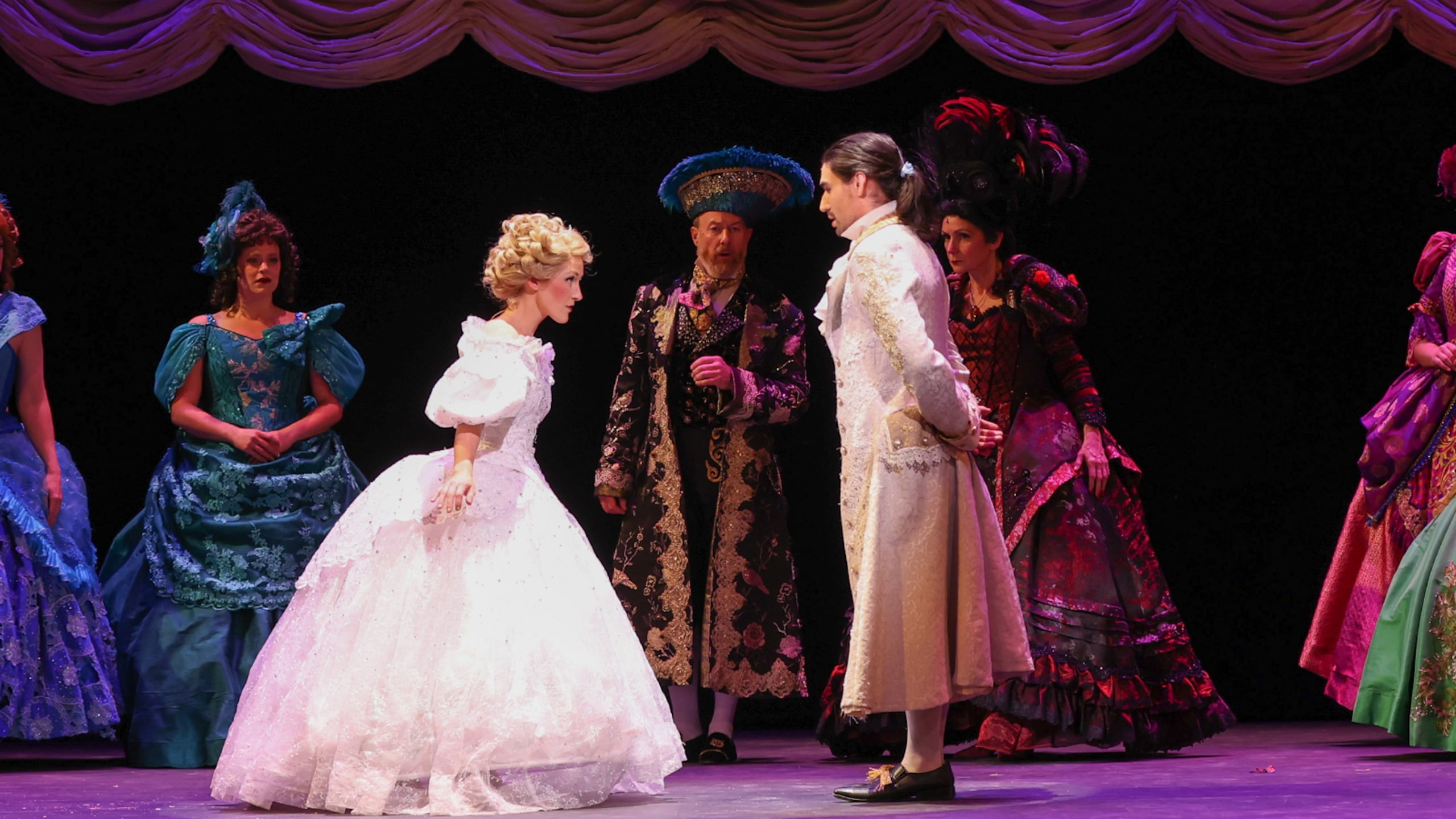There’s a moment in Broadway Rose Theatre’s production of Rodgers + Hammerstein’s Cinderella when Ella (Jennifer Davies) quietly lays her head in the lap of her cruel stepmother (Lisamarie Harrison). The tender gesture is small but stunning and shows us that no matter how familiar we are with the folk tale, it still has more to tell us.
Throughout this luminous production, such visual delights gleam as brightly as its famous songs, which include “Impossible,” “A Lovely Night,” and “There’s Music in You.” Perhaps that’s because the show’s director, Lyn Cramer, is its choreographer, too. Thanks to her brilliant staging, the movement in every scene is breathtaking, whether Ella is running through the forest clutching a pumpkin while knights holding lanterns swoop low and high in hot pursuit or the townspeople are performing delicate heel digs and elegant kicks executed while supporting themselves in handstands.
The sparkles, puffs, and jewel-toned colors of the costumes also add to the dazzle of the play, which is a 2013 adaptation of the musical, with an updated book by Douglas Carter Beane. This time, the stepmother, now called Madame, is dressed in glimmering black and blood-red gowns. Sure, her words are as nasty as ever (she has a bit where she repeatedly calls the stepsisters her “real daughters” or her “daughters who count”), but her clothes alone say plenty about her character before she even opens her mouth.
Kristeen Willis’ lighting also adds to the enchanting picture-book quality of the production. This is especially true when the ensemble gleefully waves their ivory invitations to the ball against a purple-lit backdrop and also when a field of twinkle lights suggest a rural night sky.
As a story, Cinderella has come a long way from the folk tale the Grimm brothers recorded, a gory yarn called “Ashputtle” (which features blood spurting from the stepsisters’ feet and birds that pluck out their eyes). Charles Perault prettied up the story in the 17th century, as did Disney in various versions. All these stories, though, include a common theme: Patience and virtue are rewarded in the end.
Like her predecessors, this Ella is nice to everyone, even the poverty-stricken pariah “Crazy Marie” (a golden-voiced Leah Yorkston). Beane’s book, though, takes this niceness a few steps further by having Ella and other characters dream of taking action to improve the world.
At times, this can lead to some clunky lines that weigh down the story a bit, like when Topher (Eric Asakawa), the prince, tells Ella, “You make me wish I was a better person.” Such additions also add to the length of the play, as in the scene at the palace where Madame plays a snarky game called “Ridicule” with relish, but Ella gets everyone complimenting each other instead. By contrast, one magical feat of Disney’s 1997 made-for-television version of Cinderella, which starred the singer Brandy, was that its gloriously diverse casting made a powerful visual statement about social justice without adding a single line on the topic.
Beane’s wordier book, however, is also peppered with comedic one-liners. When Ella runs away at midnight, the stricken Topher cries, “She’s my destiny!” in a dramatic voice that pokes fun at romantic tropes. One of the stepsisters, Gabrielle (Lorna Baxter), is hilarious, too, as she announces she’s going to start volunteering at a soup kitchen, exclaiming, “I get to ladle!”
The talent of Broadway Rose’s cast complements Beane’s mission to create more three-dimensional characters. Harrison reveals a hint of humanity behind Madame’s money-grubbing heart, and Davies and Asakawa, with their gorgeous singing, make the relationship between Ella and Topher genuinely touching. This is especially true when they sing the sweeping “Ten Minutes Ago” while the ensemble gently waltzes behind them.
When the Grimm brothers, who were German, first published their collection of folk tales in 1812 and 1815, they didn’t realize that the same stories resonated with other cultures. In fact, there are many Cinderella-type stories throughout the world, such as China’s Tang Dynasty tale of Ye Xian. Does the addition of yet another Cinderella who also happens to be an activist reflect the values of the average American today? We can only hope it’s possible.
SEE IT: Rodgers + Hammerstein’s Cinderella plays at the Deb Fennell Auditorium, 9000 SW Durham Road, Tigard, 503-620-5262, broadwayrose.org. 7:30 pm Thursday-Saturday and 2 pm Saturday and Sunday, through Aug 20. $20-$60.
